Photo
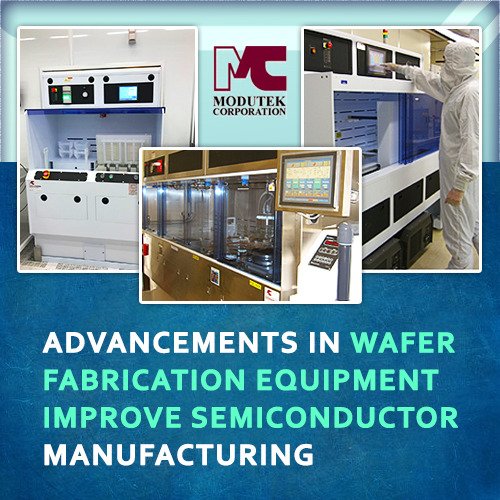
Advancements in Wafer Fabrication Equipment Improve Semiconductor Manufacturing
The improvements in wafer fabrication equipment have kept up with the growing industry demands in high precision wafer fabrication. Precision is required to ensure adequate output quality and a low component rejection rate.
Automation has become the norm since it requires minimal manual handling. More so, it is needed to meet stringent requirements which allow fabrication shops to boost their productivity, minimize errors, reduce waste, and prevent additional costs.
Modutek offers fully automated wafer fabrication equipment which provides fully automated control of the wafer fabrication process. It has integrated software such as Modutek's SolidWorks Flow Simulation and SolidWorks Simulation Professional which allow operators to calculate process variables and track chemical usage. Once the process is programmed, the advanced robotics will execute the process steps without intervention or monitoring from the human user. This results in a consistent process environment, increased throughput and increased output quality.
Both the software and the robotics have significantly improved process control, reliability and efficiency. Since a lot of semiconductor suppliers have their own requirements for different kinds of wafer manufacturing, Modutek designs the equipment, assembly and testing, and even the software, to match these specific customer requirements.
The last etch process involves etching the silicon wafer to remove the silicon oxide layer and then drying the cleaned wafer in a drying chamber. At this stage, any contamination can negatively affect later processes and will result to semiconductor components of inferior or defective quality. Modutek's newest product introduces the combination of the last etch (HF) and IPA drying chamber to prevent handling the silicon wafer and thus reduce its chances of contamination.
Read the complete article titled “Advancements in Wafer Fabrication Equipment Improve Semiconductor Manufacturing” to learn more about Modutek’s advancements. If you would like to discuss your particular needs, would like to schedule a free consultation, or have questions, call Modutek at 866-803-1533 or send an email to [email protected].
#wafer fabrication equipment#semiconductor equipment manufacturer#semiconductor manufacturing equipment
0 notes
Photo
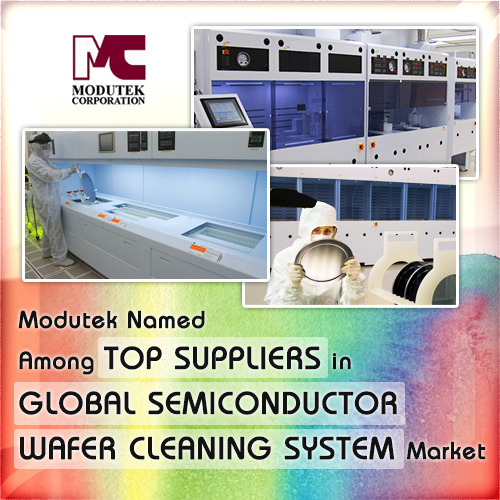
Modutek Named Among Top Suppliers in Global Semiconductor Wafer Cleaning System Market
Modutek, a leading supplier of wet bench technology, wet processing and chemical handling stations, is recently named among the top suppliers in the global semiconductor wafer cleaning system market report, published on eMarkets Europe.
The company has been a semiconductor equipment manufacturer for more than 35 years, and has built a reputation for innovation, in house expertise and high quality customer support. Modutek's wet bench stations support all common chemical process used for wafer fabrication. It has developed its own innovative software and process steps to ensure increased throughput while reducing chances of human errors, costs as well as defective or inferior semiconductor wafers.
Modutek has been supplying high-quality manufacturing equipment that meets the specific needs of a customer’s processing requirements. Their wet bench stations use the latest advanced technology to execute a client’s process precisely. As top supplier, Modutek knows the details of the different etching, stripping and cleaning process and designs equipment and software that will handle these processes efficiently, effectively and safely.
By introducing new and innovative solutions in an ever-changing semiconductor industry, Modutek’s systems allow for increased productivity while reducing costs. Modutek’s products allow customers to maintain or increase yields in the face of challenges from denser component packing and more complex microstructures on silicon wafers.
Apart from the experience, Modutek distinguishes itself through its in-house expertise and experience. The company's engineers develop their own equipment, design the software, which are all assembled and tested in-house. This results to unequaled and exceptional service and support without requiring third parties for additional assistance.
Modutek has been recognized as a leader among the semiconductor equipment manufacturers in their industry. For further details read the complete article titled “Modutek Named Among Top Suppliers in Global Semiconductor Wafer Cleaning System Market”. For a free quote or consultation on selecting the wafer manufacturing equipment for your specific process requirements send an email to [email protected] or call Modutek at 866-803-1533.
#wafer cleaning system#semiconductor equipment manufacturer#global semiconductor wafer cleaning system market#semiconductor wafer cleaning
0 notes
Photo
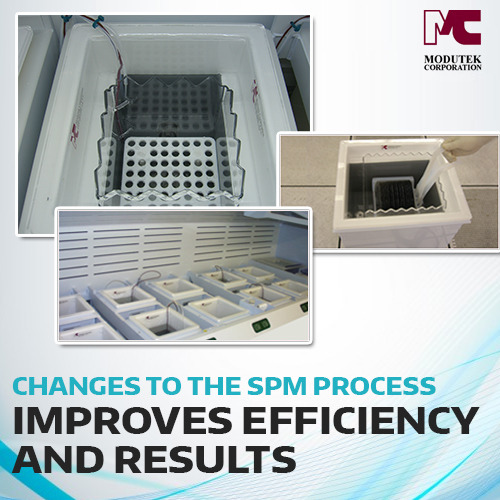
Changes to the SPM Process Improves Efficiency and Results
The sulfuric acid peroxide measure (SPM) is the process that effectively strips and cleans silicon wafers, however due to the decomposition of the hydrogen peroxide it suffers from instability. Heated baths can speed up the process, but they can affect the concentration of the hydrogen peroxide. Periodically adding the mixture with extra hydrogen peroxide, on the other hand, will maintain its concentration but it can affect the strip rate. As a result, the SPM mixture needs to be changed as frequently, and leads to high costs of chemicals and frequent downtime on wet bench stations.
Modutek has addressed the SPM issues with its new “bleed and feed” spiking system, which uses a double clean-and-dirty tank process. This new SPM strip and clean process starts by draining a programmable amount of mixture prior to each process step. Next, a programmable amount of sulfuric acid is added to a clean tank. Now both tanks have the programmable amount of hydrogen peroxide.
With the “bleed and feed” method, a complete chemical change is now only required about once a week as compared to two or three times a day. It also helps in reducing downtime and enables the process to get up again quickly. Result is less frequent changes and use of costly chemicals.
The “bleed and feed” system is also PLC-controlled, and the periodic adding/spiking of chemicals enables the mixture to be used continuously for longer periods of time. In addition this updated process is more efficient in delivering better cleaning and stripping performance.
For additional details about the SPM process upgrade on Modutek’s wet bench stations, read the complete article entitled “Changes to the SPM Process Improves Efficiency and Results.” If you need more information or have questions, please send an email to [email protected] or call Modutek at 866-803-1533.
#wet bench stations#SPM strip and clean process#wet benches#wet process equipment#wet processing equipment
0 notes
Photo

Modutek At 2018 Semicon Conference in China
Modutek Corporation, a leading provider of wet bench stations and wet process equipment, will be at the Semicon Conference in Shanghai China from March 14-16, 2018 with their factory representative Laserwort Ltd. They will be located in Hall N2 at booth 2431. Information about the Semicon Conference can be referenced at http://www.semiconchina.org/ and details on Modutek’s attendance at the conference can be referenced at: Modutek at Semicon Conference in China
Come by the Modutek /Laserwort booth to get information and answer any questions you have about using Wet Bench Process Stations for acid/base, solvent and ozone cleaning or photo resist strip. In addition Modutek will also provide information about the benefits of their new IPA vapor dryer with the HF last process. Modutek serves customers around the world who require any type of wet processing equipment and builds chemical delivery systems for pharmaceutical, biochemical, solar and semiconductor manufacturing.
Additional details on some of Modutek’s products are listed below:
Single Chamber HF Last IPA Vapor Dryer
Benefits include:
· Most drying cycles completed within 10 to 15 minutes
· Very low consumption of IPA
· No moving parts inside drying chamber eliminating wafer breakage
· Eliminates watermarks
· Drying technology can be designed into wet bench eliminating one transfer step
Features include:
· Single drying chamber for DI water rinsing and IPA vapor drying
· On board HF metering for precision mix ratios
· Uses an in situ HF etch process with a rinse step before the IPA drying cycle
· Filter bypass for contamination control with no cassette contact points
· Easy to change IPA bottles
· Handles all process sizes (standard wafer carriers to glass substrates)
Fully-automated Wet Bench Equipment
Benefits include:
· In house customization to meet customer process requirements
· Precise automated process execution and reliable repeatability
· Full automation control with touch screen
· Improved yield and reduced errors
· SolidWorks Simulation software for accurate calculation of process parameters
· All robotics and software design designed in house
· Complete design, assembly and test at one location to meet your specifications
Semi-automated Wet Bench Equipment:
Benefits Include:
· Automation control with touch screen
· Servo motor automation
· SolidWorks Flow Simulation software
· SolidWorks Simulation Professional software
· All robotics and software designed and developed in house
· Complete design, assembly and test at one location to meet your specifications
Manual Wet Bench Equipment:
Benefits Include:
· High end manual equipment at competitive pricing
· Meets or exceeds all current safety standards
· Low cost of ownership
· Designed to meet any process requirements
· Can accommodate custom designs and processes
· Equipment designed for future expansion
All wet bench equipment supports the following applications:
KOH Etching
Quartz cleaning
Ozone Strip
Ozone Cleaning
SC1 & SC2 (RCA Clean)
Megasonic Cleaning
BOE (Buffered Oxide Etching)
MEMs processing
All solvent applications
Hot phosphoric (Nitride Etching)
SPM Cleaning
Precision Part Cleaning
Modutek has over 37 years of industry experience and expertise in developing and building wet bench stations and wet process equipment that provides highly reliable results for precision processes. They also provide world-class service, and customer support. Contact Modutek at 866-803-1533 or email [email protected] for a free quote or consultation to discuss your requirements.
#wet bench stations#wet process equipment#fully-automated wet bench equipment#semi-automated wet bench equipment#manual wet bench equipment#IPA vapor dryer
0 notes
Photo
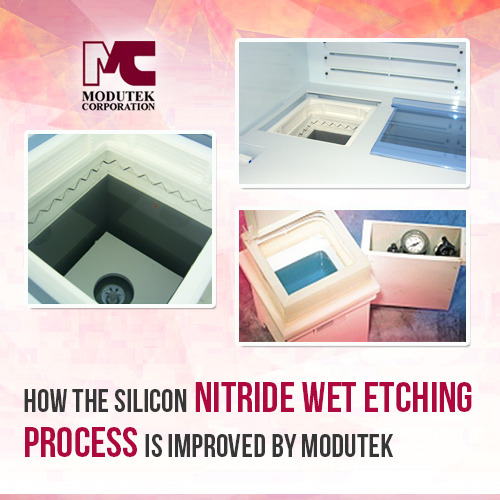
How the Silicon Nitride Wet Etching Process Is Improved by Modutek
Silicon nitride is used as a mask when etching silicon wafers as part of the semiconductor manufacturing process. Before the silicon wafer goes to the next fabrication steps, the silicon nitride needs to be removed from the wafer surface using a solution of DI water and phosphoric acid.
To optimize the silicon nitride wet etching process, the phosphoric acid solution is kept at a high temperature. This means some of the DI water boils off as steam and must be replaced. Adding water to the phosphoric acid is extremely dangerous as it can explode. Keeping the solution at a constant temperature is essential for accurate control of the stripping process.
Modutek has made significant improvements to both the safety and the control of the nitride wet etching process with its Nb series silicon nitride wet etching baths. Here, the heater that boils the solution is always switched on, which leads to the solution being heated up to the boiling point and further heating will not increase the temperature, just the boiling rate.
Just in case the temperature increases, a thermocouple in Modutek's bath gives the signal that the DI water should be added. Then, the DI water is added slowly to the boiling solution (since the acid boils rapidly) to make sure that it's mixed in immediately and doesn't form a water film on the solution's surface. If the water is added to the solution too quickly, the water film will form and mix itself with the acid, which leads to a very strong reaction and an explosion is possible.
This control strategy employed in Modutek’s system ensures the temperature of the solution is always maintained at its boiling point. Modutek’s silicon nitride wet etching baths also have additional safety features which ensure that no water is added if the solution is not boiling. Using its advanced control system with additional safety interlocks, Modutek has improved the accuracy, control and safety of the silicon nitride wet etching process.
For more details read the complete article titled “How the Silicon Nitride Wet Etching Process Is Improved by Modutek”. If you have questions or would like further information, please call Modutek at 866-803-1533 or email to [email protected].
#silicon nitride wet etching#silicon nitride wet etching baths#silicon etching equipment#silicon wet etching
0 notes
Photo

How the KOH Etching Process is Improved Using Modutek's Teflon Tanks
Among the various approaches that foundries use to manufacture semiconductors chips, the use of the KOH (potassium hydroxide) etching process is frequently preferred due to the error-free mass production capability it provides. Etching with potassium chloride (KOH) provides more precision and results to better quality control compared to dry semiconductor etching processes that present challenges in process control.
The fluids employed in the KOH etching process are stored in Teflon tanks built within the equipment – these tanks can make KOH etching more cost-effective, more practical and safer than other alternatives available. It’s also possible to structure the KOH etching process in a manner that will create an easily repeatable manufacturing process. When projects come in from different clients, fabrication plants can focus on setting up the equipment and process lines and worry less about safety and reliability issues.
One of the most significant improvements that Modutek brings to the KOH etching process is customized control. Modutek’s tanks have highly customizable temperature settings – temperature control can be achieved either through in-line heating and cooling equipment installed, or through immersion in liquid tanks. Temperature can be adjusted between 30°C to 100°C and changes can be adjusted at a rate of 2°C per minute on average depending on tank size.
Modutek designs Teflon tanks according to the specifications of each client’s installation. Whether a manufacturing facility needs recirculating baths for KOH etching processes or temperature controlled static baths, Modutek's Teflon tanks provide optimum control to reduce water loss and concentration deficiency.
For more details read the complete article titled How the KOH Etching Process is Improved Using Modutek’s Teflon Tanks. Call Modutek at 866-803-1533 if you have questions or would like a quote or email to [email protected].
0 notes
Photo

How to Improve Your Silicon Wet Etching Process
The silicon wet etching processes used by fabrication facilities and research labs needs to deliver quality results in a consistent way. The processes involved in semiconductor manufacturing include multiple steps that include cleaning, masking, and etching. These processes involve the use of various chemical baths, each of them intended to achieve a different and specific result. At the end of these accurately implemented processes, the silicon wafers that have been etched will be ready for testing.
Among the different requirements for an error-free process, the two primary ones include: 1) accurate monitoring over the speed at which the etching is done; and 2) the ability to achieve extreme levels of cleanliness in work areas in which etching is being done.
There are many ways to improve the silicon wet etching process, these include:
1) Silicon nitride – Silicon nitride is applied to mask parts of wafers during the phosphoric acid etching process. A greater precision is a must in this process to attain superior results.
2) Potassium hydroxide – The use of potassium hydroxide solution is required in the creation of microscopic structures on semiconductor wafers. Close monitoring over the concentration of the solution, the temperature, the orientation of the silicon crystal and silicon purity are required to achieve error-free and precise etches.
3) Buffered oxide etch – This process uses hydrofluoric acid apart from the buffering agent to etch fine masking films of silicon oxide or silicon nitride.
When it comes to improving the silicon wet etching process, one of the most important factors is using high quality processing equipment from an experienced and reputable vendor that provides good support. With over 35 years of experience, Modutek Corporation is ready to answer this requirement not only by supplying the right silicon wet etching equipment, but also by advising its clients on which customizations are needed to match their requirements.
If you have questions about any equipment for silicon wet etching, read our recent article titled “How to Improve Your Silicon Wet Etching Process”. Contact Modutek by phone at 866-803-1533 or email [email protected].
0 notes
Photo

Determining Which Wafer Processing Station Will Meet Your Requirements
Wet benches stations are available in various configurations which are designed for different applications. Because of this, clients may have a difficult time deciding which equipment to choose that will best meet their requirements. One way to reduce the uncertainty and to make the selection more defined is to focus on three areas where your requirements must be met.
A wafer processing station needs to address the following items:
1) Compliance with standards
Wet bench stations should comply with the following industry standards to ensure safe operation and resistance to combustion:
NFPA – National Fire Protection
NFPA 79 – Safety of Industrial Machinery
NEC – National Electrical Code
UL 508a – Standard for Industrial Control Panels
If wet bench stations have to be installed outside the US, Modutek is also able to comply with a foreign country's own local and national safety standards. In addition, Modutek can supply third-party certification for compliance.
2) Applications
Modutek can supply the right systems and advise on the benefits and advantages of certain products from their complete line of wet bench equipment, depending on the process or application required.
3) Automation
Modutek offers manual, semi-automated and fully automated wet bench stations. You should know your needs first before deciding whether you want a manual or automated model:
Manual – ideal for low volume custom or prototype device processes. It has the most competitive pricing among the three models.
Semi-automated – has some automated features and provides uniform processing without the higher priced associated with fully-automated models
Fully automated – ideal for hands-off operation and higher volume with standard processes. It improves higher throughput and minimizes human errors.
Modutek's wafer processing stations are developed and manufactured with the same high-quality materials but it can also supply the appropriate degree of automation that will meet the customer’s needs and specifications.
Read our complete article entitled “Determining Which Wafer Processing Station Will Meet Your Requirements”. If you have questions after reading it, please give Modutek a call at 866-803-1533 or send an email to [email protected].
0 notes
Photo
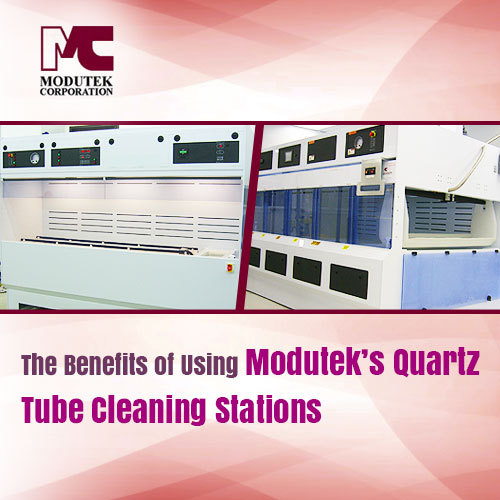
The Benefits of Using Modutek’s Quartz Tube Cleaning Solutions
Ultra-clean and reliable quartz tubes are a basic requirement to ensure a precise and smooth semiconductor wafer fabrication process. That’s why quartz tube cleaning stations are required equipment at every semiconductor wafer foundry.
The Quartz tube cleaning process requires the use of corrosive chemicals, and requires the involvement of a manufacturer and installer to design and install units specifically tuned and adjusted to meet the specific application.
Quartz tubes themselves are delicate components, they need to be handled meticulously as they can be prone to risk and damage. The ideal quartz tube cleaning process minimizes human handling at all stages. This is why automated tube cleaning stations are essential equipment for semiconductor manufacturers.
Fortunately, there are quartz tube cleaning stations today that require minimal human handling at every stage, and Modutek’s quartz tube cleaning stations do exactly just that.
Built out of white polypropylene, Modutek’s quartz tube cleaning stations are designed to keep quartz tubes in motion while they are being etched, and powerful nozzles direct water spray at the quartz tube to maximize coverage.
Units can also be custom-designed and equipped with many other options (such as automation and hot nitrogen drying processes) that can be applied for more efficient cleaning procedures. From automated program recipes to tube roller systems, every part of the process can be made more efficient with automation. Operators using the automated station will simply monitor the process through the data shown on the screen, and can control various functions remotely.
Whether you need a manual or automated quartz tube cleaning station, Modutek designs it for you in house at their facility to ensure excellent and superior performance in any installation.
For more details read the posted article titled “The Benefits of Using Modutek’s Quartz Tube Cleaning Solutions”. If you want a quote or consultation on selecting equipment for your specific application call Modutek at 866-803-1533 or email [email protected].
0 notes
Photo

Custom Fabrication Services for Unique Wafer Processing Requirements
Research labs and semiconductor manufacturing facilities often have special requirements for certain projects or prototypes that may need custom equipment to support their manufacturing procedures.
Semiconductor manufacturing facilities may need customized tanks, carriers or chemical stations to manufacture a particular product or may need to change existing equipment based on external changes or new requirements.
When new products are developed, single items are manufactured, or prototypes are done for testing, existing wafer processing equipment being used may not be suitable for the job. There are many factors: changing suppliers and/or environment and safety regulations imposing additional requirements or changing existing ones. In such cases, retrofitting the equipment, adding new components or changing parts or any other customization may be the best and most cost-effective solution to meet the current requirements.
On the other hand – other semiconductor manufacturers want to customize their existing equipment to let themselves adapt their production lines to current requirements, to speed up production and to increase throughput.
Fortunately, Modutek can provide expertise and experience to manufacturers when customized solutions are needed to support their unique wafer processing equipment requirements.
With over 35 years of experience supporting the needs of the semiconductor manufacturers and research facilities, Modutek specializes in custom design and development. They offer a wide range of customizations that include retrofitting equipment, upgrading stations, improving chemical delivery systems, etc., to meet client specifications, safety standards and environmental regulations. By using their expertise and experience to design and build customized equipment, Modutek’s engineers know exactly what works best and how existing equipment can be modified to meet any specialized requirements.
If you have questions, or would like a free estimate, after reading our full article “Custom Fabrication Services for Unique Wafer Processing Equipment,” please feel free to call Modutek at 866-803-1533 or send an email to [email protected].
0 notes
Photo
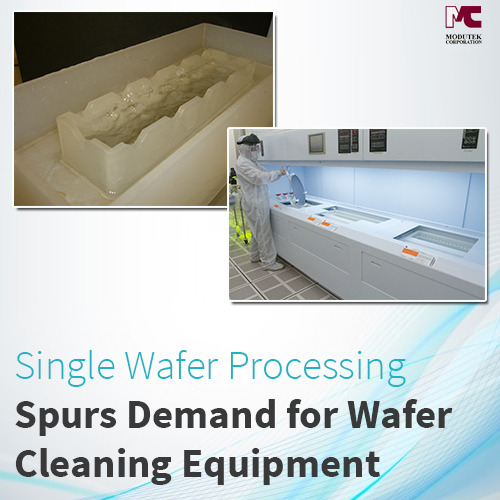
Single Wafer Processing Spurs Demand for Wafer Cleaning Equipment
Wafer cleaning equipment suppliers regularly invest heavily in research and development in order to stay abreast of the ever-changing market trends. It also helps them meet the high demands of certain industries such as semiconductors, printed electronics, and single wafer processing.
More and more operators are jumping into the semiconductor equipment industry. Thus, the trend fuels the high demand for wafer cleaning equipment.
Single wafer processing is one of the factors that drive the global wafer cleaning equipment market's continuous growth. Single wafer processing uses ozonized wafer and hydrofluoric acid in a single spin technology to reduce cycle times and boost output flexibility.
Single wafer cleaning equipment becomes competitive but only when the cycle times for individual wafers are low and the quality of the output can be comparable to wet batch processing. It can be used to etch silicon and provide a wet process for mini-fab single wafer cleaning. This process is often done together with megasonic cleaning because it helps in removing the tiniest particles and impurities, resulting in low particle count for the finished substrate.
Some single wafer processes are attractive because their deliver better results than the use of traditional process. The use of megasonic cleaning in particular reduces particle counts for even the smallest particles. The cleaning method uses megasonic sound waves in the cleaning solution which generate cavitation bubbles. These bubbles can remove the very small particles from the substrate surface. This type of cleaning is better than the traditional methods as it uses no harsh chemicals and reduces particle counts.
As semiconductor equipment manufacturers embrace single-wafer processing, the demand for single wafer cleaning equipment will increase significantly.
For more information read the complete article “Single Wafer Processing Spurs Demand for Wafer Cleaning Equipment”. If you would like a free estimate or have questions, contact Modutek by email to [email protected] or by calling 866-803-1533.
0 notes
Photo
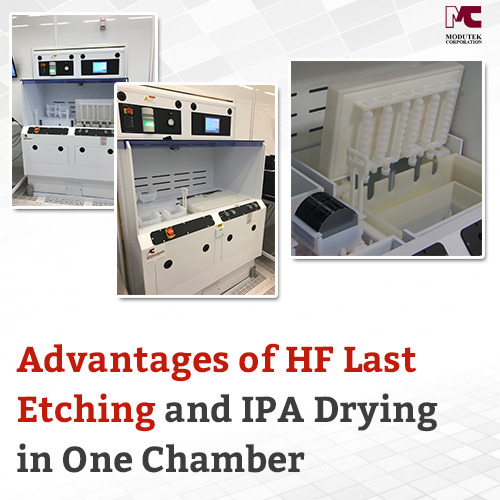
Advantages of HF-Last Etching and IPA Drying in One Chamber
After cleaning, a silicon wafer needs to be effectively cleaned and dried with no particle contamination. Clean wafers are important to avoid errors in the next processing steps to produce devices that are of superior quality and free from defects. Using the single chamber HF-last and IPA vapor dryer show a considerable reduction in wafer substrate particle counts.
By the final stage of silicon wafer cleaning, the silicon oxide layer has to be removed and the cleaned wafer dried free from contaminants. However, transferring the wafers from the HF etching process to a separate drying chamber will likely cause the wafers to pick up particles.
Modutek now has a solution to this problem: the single-chamber HF-last and IPA vapor dryer, which can help to significantly reduce the particle count on wafer substrates.
In the single chamber process, Modutek uses IPA vapor drying in a free-standing unit with one DI water rinsing and drying. This method, also called the Marangoni drying technique, results in clean wafer substrates -- having no contamination or watermarks.
Modutek has modified the IPA vapor dryer to include HF (hydrofluoric) acid injection before the start of the standard IPA vapor drying process. The HF acid injection ratio is controlled and provides an etch to bare silicon. When the silicon is etched, it is then rinsed to a controlled pH level. Once the appropriate pH levels are reached, it is then followed by the IPA drying process without moving the silicon wafers. This results in the low particle count on the wafer.
Initial field results from the single chamber HF-Last IPA dyer that Modutek has supplied to customers are showing outstanding results. Within the 0.3 to 5 micron range, fewer than 20 particles (adders) were added to etched substrates which are substantially below what was achieved in previous processes in this field trail.
For more details read the complete article “Advantages of HF-Last Etching and IPA Drying in One Chamber” to learn more about Modutek’s IPA vapor dryers. Call Modtuek at 866-803-1533 or send an email to [email protected] if you have questions or would like to get a free consultation.
0 notes
Photo
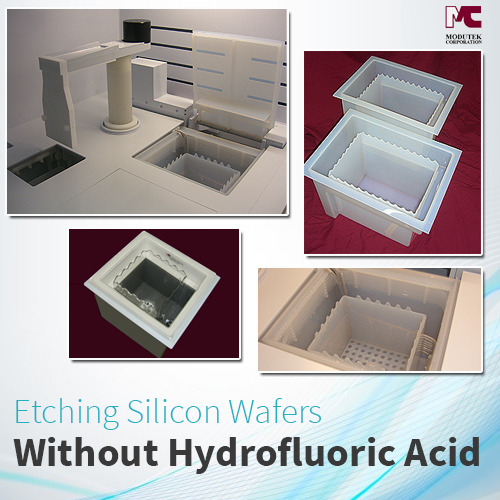
Etching Silicon Wafers Without Hydrofluoric Acid
Hydrogen fluoride is an excellent etching chemical for silicon wet etching in wafer fabrication, etching rapidly to remove silicon oxide, for example, after an initial RCA clean. Although it is effective, hydrogen fluoride is toxic, dangerous and can be deadly if proper procedures are not followed.
Some of the dangers of exposure to hydrofluoric acid include:
· Vapor that can cause lungs to fill up with liquid
· Affects nerves at sites where the skin has been exposed to the acid and initially, the victims may feel a little pain as a result.
· Can penetrate deep into the body and destroy the tissues and bones. This often can cause long-lasting damage.
· Disrupts calcium chemistry of the blood, eventually leading to cardiac arrest.
· Even a small amount can cause skin burns that may be slow to heal. It can also result in death if treatment is delayed.
Hydrofluoric acid is also a hazardous waste and its discharge is tightly regulated. The acid must first be neutralized and the discharge limits on fluoride and metals must be followed. The safety and environmental considerations have resulted in the search for alternatives.
Depending on the specific silicon wet etching application, other etching chemicals may be used which are more suitable and safer replacements for hydrofluoric acid. Some of these include potassium hydroxide (KOH), tetramethylammonium hydroxide (TMAH) and nitride etch.
Modutek can help customers make the change by recommending equipment that supports an alternative chemical etchant. The company has over 35 years of experience and expertise in providing wet bench and wafer fabrication equipment and can advise customers about alternatives.
Read the complete article “Etching Silicon Wafers Without Hydrofluoric Acid” to get more details. If you have questions or would like a free quote or consultation, please contact Modutek at 866-803-1533 or email [email protected].
0 notes
Photo
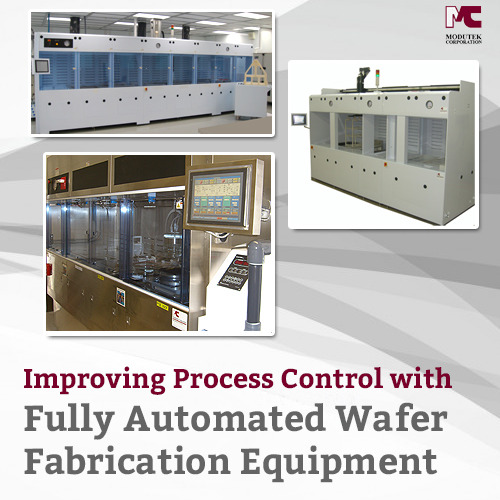
Improving Process Control with Fully Automated Wafer Fabrication Equipment
An increasing number of wafer fabrication applications require tight process control. Accurate chemical dosage and precise process timing become critical for a high-quality output.
Manual and semi-automated controls are susceptible to human error and a variation in how process steps are carried out. These processes can be improved with the use of fully-automated wet benches and chemical stations which help with consistent execution.
The combination of fully automated wafer fabrication process and software ensures better repeatability, minimized waste and improved production line performance.
Modutek designs and manufacturers their fully automated wafer fabrication equipment in-house to ensure the highest quality standards are met. In addition, Modutek has developed their own SolidWorks Simulation Professional and SolidWorks Flow Simulation software, which will provide a consistent automated process and ensure correct dosages. The software can also perform simulations and track chemical use.
Modutek offers standard wet bench chemical stations or customized equipment to meet the customers' exact standards and specific application. They can handle both solvent and acid applications, and the equipment can process sizes up to 30 inches by 60 inches.
There are a number of benefits in using fully automated wafer fabrication equipment. The process is set up and can be run repeatedly with minimal monitoring. It also allows for improved process control and accurate chemical dosage, precise timing of process steps, exact replication of the process sequence, and full neutralization of chemical waste. A fully automated process also reduces the use of chemicals. Process output remains consistent, the number of defective results is low, and production line and productivity are improved.
Read the entire article “Improving Process Control with Fully Automated Wafer Fabrication Equipment” and then call Modutek at 866-803-1533 to get a free consultation. You may also send an email to [email protected] with any questions you may have.
#wafer fabrication equipment#wafer processing equipment#wet bench stations#semiconductor manufacturing equipment
0 notes
Photo
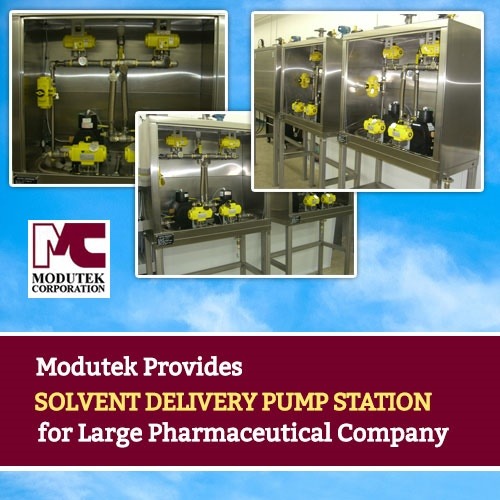
Modutek Provides Solvent Delivery Pump Station for Large Pharmaceutical Company
Modutek can develop and produce complex and wide-ranging chemical delivery systems that meet challenging customer requirements. As a semiconductor manufacturing company with over 35 years of experience, Modutek delivered its most recent project: providing solvent delivery pump supply for a large pharmaceutical company.
In this project, Modutek supplied nine solvent pumping cabinets, each equipped with two pneumatically-operated pumps. These pumps have pulse dampers and are fitted with air-actuated ball valves on the inlet/outlet of each pump. The pilot valve will regulate the supply of clean, dry air (CDA). A series of valves and monitoring system controls ensures the transfer of solvents to distribution points close to the process.
Each custom-built cabinet has an ultrasonic leak detector housed in a one-inch pipe “T” at the lowest point of the cabinet. The cabinet also features a drain “On/Off” selector and a 4-20 ma pressure transmitter.
The Programmable Logic Controller (PLC) controls these pumps, which in turn will deliver up to four gallons per minute.
When the request for a pump is received, the drain valve “On” function shuts off while the pilot valve supplying CDA to the pump opens. The ball valves then open, allowing the solvent to flow from the pump inlet and past the pressure transmitter to the process.
When the drain valve is turned “On,” the pilot valve, the discharge ball valves, and the pump inlet are disabled. The drain valve opens and the solvent is discharged and transferred into a collection container. Once draining process is completed, the operator can shut off the drain valve, resuming the normal operation of the pumps.
In case the ultrasonic leak detector in the pipe “T” recognizes a leak, the pilot valve, and the corresponding ball valves close, stopping the transfer of the solvent.
Solvents handled include acetone, methanol, ethyl acetate, heptane, isopropyl acetate and methyl tert-butyl ether.
Modutek can help manufacturers with complex chemical delivery systems by developing customized equipment to meet specific requirements. All chemical handling and delivery system equipment designed by Modutek is designed and manufactured in-house at their facility in San Jose California.
If you have questions after reading the complete article “Modutek Provides Solvent Delivery Pump Station for Large Pharmaceutical Company”, contact Modutek for a free consultation at 866-803-1533.
#chemical delivery system#chemical delivery systems#semiconductor equipment manufacturers#semiconductor manufacturing equipment
0 notes
Photo
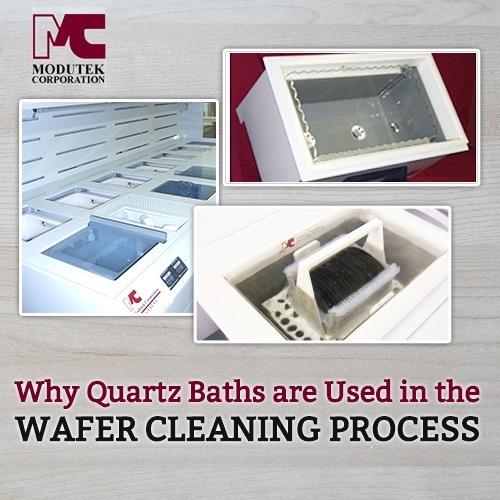
Why Quartz Baths Are Used in the Wafer Cleaning Process
The cleaning of silicon wafers during semiconductor manufacturing uses harsh chemicals to remove deposits from the silicon’s surface.
The semiconductor manufacturing process includes multiple steps, each of which may require cleaning the silicon wafer before or after the production process segment. Highly corrosive chemicals (like sulfuric acid and hydrogen peroxide) are used to remove impurities.
For effective cleaning of the silicon wafer:
· The contaminants and impurities should be completely removed.
· The container used should be of an impervious nature.
· There needs to be tight control of the bath temperature.
Without controlling these three factors during the wafer cleaning process, manufacturing such as diffusion will be affected. Even the smallest remaining particle of contaminant can obstruct an electrical connection and affect electrical characteristics. The resulting semiconductor device will be unreliable or defective.
Baths made from high purity quartz don’t react with the corrosive chemicals used in semiconductor manufacturing and are inert as a source of contamination. Thus, a high-quality quartz bath is an ideal container for the semiconductor wafer cleaning process.
During the cleaning process, the silicon wafers are immersed in a chemical within the quartz bath. The baths may be heated depending on the cleaning process, to a given temperature for a certain time period, and chemicals may be re-circulated. The chemicals in the quartz bath remove organic impurities from the surface of the wafers. Then the step of rinsing and drying the wafers will follow. The wafers are then immersed in a mixture of hydrochloric acid and hydrogen peroxide, where the metallic impurities are removed. After that, the wafers will be subjected to processing steps.
Quartz baths, such as Modutek series QFa re-circulating baths, facilitate reliable cleaning of silicon wafers.
If you have questions about how quartz baths are used in the wafer cleaning process, please read the complete article “Why Quartz Baths Are Used in the Wafer Cleaning Process”. Contact Modutek at 866-803-1533 to discuss your specific wafer cleaning needs.
0 notes
Photo

Selecting Equipment for the KOH Wafer Etching Process
KOH (potassium hydroxide) etching has become increasingly important as a solution in creating microscopic structures in silicon. The wafer etching process using KOH etching is relatively safe and can be monitored by regulating the bath temperature and doping of the silicon.
The silicon wafer (which is masked with a material that's impenetrable by KOH, most often silicon dioxide or silicon nitride) is immersed in the KOH solution. In order to reach a desired etch rate, the temperature must be controlled. KOH etching is extremely sensitive to temperature variations at temperatures at 60 degrees centigrade and above, that's why accurate control of the temperature is a key factor to produce accurate etching results.
Aside from the variations of temperature, the orientation of the crystal planes in the silicon and the doping of the silicon with boron can also significantly affect the rate and the direction of the etch.
Selecting the right KOH equipment will lead to delivering precise etching results you expected. Modutek supports KOH etching as one of the wafer etching process options within their wet bench process stations.
Modutek's equipment includes the TFa and TT series Teflon heated tanks which are ideal for supporting KOH etching requirements. The tanks are available in standard size (for single or double capacity) or customized sizes.
The TFa series high-temperature overflow tanks and the TT series static tanks are both PFA Teflon tanks with a Teflon-covered liquid path. It also includes the 360-degree overflow filtration through serration overflow, a condensing Teflon refluxor with Teflon cooling units (optional), an aspirator valve system, a pneumatically actuated auto cover, as well as a Teflon gravity drain.
Learn more about “Selecting Equipment for KOH Wafer Etching Process” by reading the main blog article. You contact Modutek at 866-803-1533 for a free consultation or quote, or send an email to [email protected].
#KOH etching#wafer etching process#wafer etching process options#semiconductor equipment manufacturers#wet process equipment#Teflon tanks
0 notes